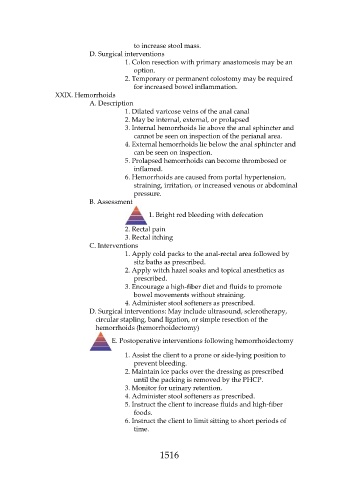Page 1516 - Saunders Comprehensive Review For NCLEX-RN
P. 1516
to increase stool mass.
D. Surgical interventions
1. Colon resection with primary anastomosis may be an
option.
2. Temporary or permanent colostomy may be required
for increased bowel inflammation.
XXIX. Hemorrhoids
A. Description
1. Dilated varicose veins of the anal canal
2. May be internal, external, or prolapsed
3. Internal hemorrhoids lie above the anal sphincter and
cannot be seen on inspection of the perianal area.
4. External hemorrhoids lie below the anal sphincter and
can be seen on inspection.
5. Prolapsed hemorrhoids can become thrombosed or
inflamed.
6. Hemorrhoids are caused from portal hypertension,
straining, irritation, or increased venous or abdominal
pressure.
B. Assessment
1. Bright red bleeding with defecation
2. Rectal pain
3. Rectal itching
C. Interventions
1. Apply cold packs to the anal-rectal area followed by
sitz baths as prescribed.
2. Apply witch hazel soaks and topical anesthetics as
prescribed.
3. Encourage a high-fiber diet and fluids to promote
bowel movements without straining.
4. Administer stool softeners as prescribed.
D. Surgical interventions: May include ultrasound, sclerotherapy,
circular stapling, band ligation, or simple resection of the
hemorrhoids (hemorrhoidectomy)
E. Postoperative interventions following hemorrhoidectomy
1. Assist the client to a prone or side-lying position to
prevent bleeding.
2. Maintain ice packs over the dressing as prescribed
until the packing is removed by the PHCP.
3. Monitor for urinary retention.
4. Administer stool softeners as prescribed.
5. Instruct the client to increase fluids and high-fiber
foods.
6. Instruct the client to limit sitting to short periods of
time.
1516

